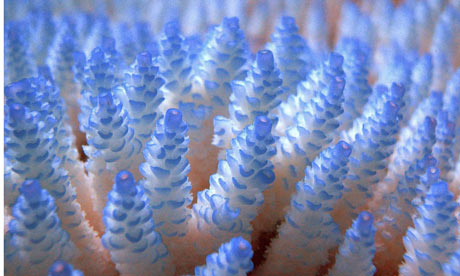Lucky combination of circumstances means corals have unexpectedly grown back within a year

Coral at the Great Barrier Reef Photograph: HO/REUTERS
Sections of coral reef in Australia's Great Barrier Reef have made a "spectacular" recovery from a devastating bleaching event three years ago, marine scientists say.
In 2006, high sea temperatures caused severe coral bleaching in the Keppell Islands, in the southern part of the reef — the largest coral reef system in the world. The damaged reefs were then covered by a single species of seaweed which threatened to suffocate the coral and cause further loss.
A "lucky combination" of rare circumstances has meant the reef has been able to make a recovery. Abundant corals have reestablished themselves in a single year, say the researchers from the University of Queensland's Centre for Marine Studies and the ARC Centre of Excellence for Coral Reef Studies (CoECRS).
"Three factors were critical," said Dr Guillermo Diaz-Pulido. "The first was exceptionally high regrowth of fragments of surviving coral tissue. The second was an unusual seasonal dieback in the seaweeds, and the third was the presence of a highly competitive coral species, which was able to outgrow the seaweed."
Coral bleaching occurs in higher sea temperatures when the coral lose the symbiotic algae they need to survive. The reefs then lose their colour and become more susceptible to death from starvation or disease.
The findings are important as it is extremely rare to see reports of reefs that bounce back from mass coral bleaching or other human impacts in less than a decade or two, the scientists said. The study is published in the online journal PLoS one.
"The exceptional aspect was that corals recovered by rapidly regrowing from surviving tissue," said Dr Sophie Dove, also from CoECRS and The University of Queensland.
"Recovery of corals is usually thought to depend on sexual reproduction and the settlement and growth of new corals arriving from other reefs. This study demonstrates that for fast-growing coral species asexual reproduction is a vital component of reef resilience."
Last year, a major global study found that coral reefs did have the ability to recover after major bleaching events, such as the one caused by the El Niño in 1998.
David Obura, the chairman of the International Union for Conservation of Nature climate change and coral reefs working group involved with the report, said: "Ten years after the world's biggest coral bleaching event, we know that reefs can recover – given the chance. Unfortunately, impacts on the scale of 1998 will reoccur in the near future, and there's no time to lose if we want to give reefs and people a chance to suffer as little as possible."
Coral reefs are crucial to the livelihoods of millions of coastal dwellers around the world and contain a huge range of biodiversity. The UN's Millennium Ecosystem Assessment says reefs are worth about $30bn annually to the global economy through tourism, fisheries and coastal protection.
But the ecosystems are under threat worldwide from overfishing, coastal development and runoff from the land, and in some areas, tourism impacts. Natural disasters such as the earthquake that triggered the Indian Ocean tsunami in 2004 have also caused reef loss.
Climate change poses the biggest threat to reefs however, as emissions of carbon dioxide make seawater increasingly acidic.
Last year a study showed that one-fifth of the world's coral reefs have died or been destroyed and the remainder are increasingly vulnerable to the effects of climate change.
The Global Coral Reef Monitoring Network says many surviving reefs could be lost over the coming decades as CO2 emissions continue to increase.


